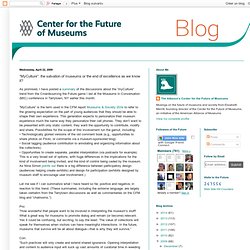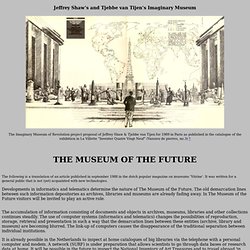

IVC #11: "Obsolescence and Exchange in Cedric Price's Dispensable Museum" by Lucia Vodanovic. The work of the British architect Cedric Price appears to revolve around an unusual relationship between preservation and demolition.

Insisting that architecture has to be contemporary in absolute terms, he destroys any traces that the past and its demands have left. Accordingly, most of his projects take the form of flexible structures that can be built, un-built, changed, re-organized, or dismantled. The architect believes that buildings should not be aimed at lasting functionally or aesthetically into the future and, for this reason, demolition plays an important role within his projects. Yet this formulation is also able to act as a form of preservation, not related to a particular building or structure but rather to the capacity of Price's constructions to be transformed and exchanged, to become one thing or another, and to continue to be contingent.
This paper aims to show how Price's work is a valuable source for rethinking the museum. Built Obsolescence Limbo Space. Opposing_forces. “MyCulture”: the salvation of museums or the end of excellence as we know it? As promised, I have posted a summary of the discussions about the “myCulture” trend from the Crowdsourcing the Future game I led at the Museums in Conversation (MIC) conference in Tarrytown, NY earlier this month.

“MyCulture” is the term used in the CFM report Museums & Society 2034 to refer to the growing expectation on the part of young audiences that they should be able to shape their own experience. This generation expects to personalize their museum experience much the same way they personalize their cell phones. They don’t want to be presented with only static content, they want the opportunity to contribute, modify and share.
Let me see if I can summarize what I have heard so far, positive and negative, in reaction to this trend. Spatial%203D%20infrastructure. University - Intypes: White Box. White Box White Box, an undecorated space with white walls, white ceiling and a continuous neutral floor, originated in 1927 as clean envelope, a bare white architecture.

An influential 1930 MoMA exhibition secured it as a museum aesthetic. more White Box | Museum application The White Box, the dominant twentieth-century practice regarding art museum interior design and architecture, makes objects untouchable and exclusive by displaying collections on a null white wall as a neutral canvas. research. The Museum of the Future. The following is a translation of an article published in september 1988 in the dutch popular magazine on museums 'Vitrine'.

It was written for a general public that is not (yet) acquainted with new technologies. Bau09.pdf (application/pdf-Objekt) The museum of the future is... What will the museum of the future look like? I wrote this post for a more general audience at BlogHer, but the post ended up including a nice round-up of links, so I’m sharing it here as well, along with a couple of provocative questions near the end of the post.

Late last year, the American Association of Museums released a discussion paper titled Museums & Society 2034: Trends and Potential Futures. The report looked back 25 years to 1984 as it predicted what museums will look like 25 years from now. Specifically, the 20-page report examined “demographic trends, changes in the geopolitical and economic landscape, shifts in technology and communications, and the rise of new cultural expectations.” For example, after pointing out that a larger percentage of the U.S. population will be senior citizen in 2034 than are seniors now, the report suggests museums will not only be accessible to people using walkers or wheelchairs, but will sport larger exhibit labels and will incorporate aspects of universal design as a matter of course. Innovation in arts and culture #2: the Social Interpretation project at IWM. Just last week we launched the NESTA funded Social Interpretation (SI) project at the Imperial War Museum (IWM).
As part of the museum's exhibition, A Family in Wartime, interactive comment kiosks have been installed next to six of the objects on display. Next to each we've asked a question for the public to respond to, and next to an evacuee label we asked: "Would you part with your children during war time? " I saw one small child typing in the response: "If Daddy sends me away I'll call Childline! " And so Social Interpretation went live. SI is a partnership between the IWM, UCL's Centre for Digital Humanities, Knowledge Integration Ltd, Gooii Ltd and with keen ethnographic researchers from the Universities of Exeter and Salford following on closely behind. Museums of the future: providing the personal, collaborating with the crowd. The museum of the future might offer a highly-personalised experience.

Photograph: Hufton + Crow / View Pictures It was a meeting of museum minds as the Guardian Culture Professionals Network hosted an online live chat: What's next for museums? The discussion was just in time for ACE's announcement of the nine successful applicants to the Museum development fund, an £8m injection as part of the Arts Council's wider £129m Renaissance programme. Served up on the debate table were several questions: where should museums be looking to improve and develop? What tools and skills can help them do it?